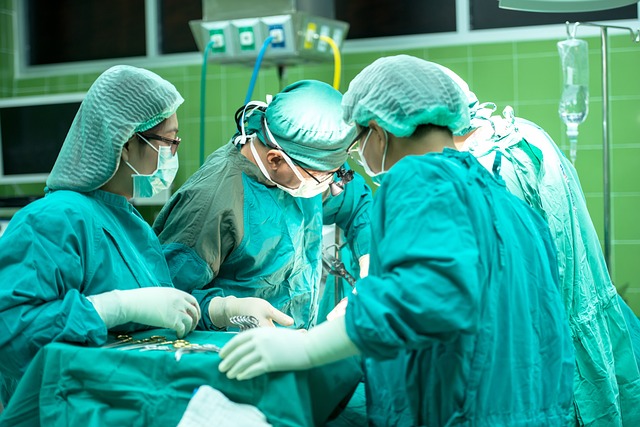Targeted regenerative treatments, including cell therapies and advanced biomaterials, are transforming post-operative care by speeding up healing, reducing inflammation, and personalizing recovery plans. These innovations, such as mesenchymal stem cells (MSCs) and platelet-rich plasma (PRP), offer benefits like shorter hospital stays, lower complication risks, and improved patient satisfaction. Effective post-op care requires patient education, multidisciplinary teams, and timely interventions, with AI and 3D printing techniques promising further advancements in healing outcomes.
In the realm of modern medicine, targeted regenerative treatments are revolutionizing surgical recovery. This comprehensive guide delves into the transformative potential of these advanced therapies for optimal post-operative care. We explore the benefits of integrating regenerative therapies in surgical recovery plans, uncover popular treatments and their applications, and outline best practices for effective implementation. Furthermore, we scrutinize emerging trends shaping targeted regenerative treatments, setting the stage for a future where post-operative care is swift, effective, and personalized.
- Understanding Targeted Regenerative Treatments for Optimal Post-Operative Care
- Benefits of Integrating Regenerative Therapies in Surgical Recovery Plans
- Popular Targeted Regenerative Treatments and Their Applications in Surgery
- Best Practices for Effective Implementation of Regenerative Post-Operative Care Protocols
- Future Trends Shaping Targeted Regenerative Treatments in Surgical Recovery
Understanding Targeted Regenerative Treatments for Optimal Post-Operative Care

Targeted regenerative treatments are transforming the landscape of post-operative care, offering a promising approach to optimize healing and recovery after surgery. These advanced therapies go beyond traditional methods by stimulating the body’s natural regenerative processes, promoting tissue repair, and reducing inflammation. By focusing on specific areas of injury or damage, such as muscles, tendons, or bones, these treatments aim to accelerate the body’s inherent ability to heal itself.
In the realm of post-operative care, targeted regenerative treatments provide a game-changer for healthcare professionals. They offer a more precise and effective way to manage surgical recovery, addressing individual patient needs and promoting faster, smoother transitions from surgery to healing. This personalized approach ensures that each patient receives tailored support, ultimately enhancing overall post-operative outcomes and patient satisfaction.
Benefits of Integrating Regenerative Therapies in Surgical Recovery Plans

Integrating regenerative therapies into surgical recovery plans offers a multitude of benefits for patients, significantly enhancing their post-operative care experience. These treatments, ranging from cell therapies to tissue engineering, possess the remarkable ability to stimulate the body’s inherent healing mechanisms, thereby expediting the recovery process. By harnessing the power of regeneration, medical professionals can potentially reduce recovery times, lessen the need for prolonged hospitalization, and minimize the risk of complications associated with traditional post-operative care.
Moreover, regenerative therapies present a promising approach to personalized medicine. Tailored to individual patient needs, these treatments can optimize healing outcomes, ensuring patients return to their normal routines faster and safer. This precision-based strategy not only improves overall patient satisfaction but also places a lesser burden on healthcare systems by reducing the resources required for extended rehabilitation.
Popular Targeted Regenerative Treatments and Their Applications in Surgery

In the realm of modern medicine, targeted regenerative treatments have emerged as game-changers in surgical recovery, revolutionizing post-operative care. Among the popular choices, cell therapy stands out for its ability to stimulate the body’s inherent healing mechanisms. This involves injecting specialized cells directly into the site of injury or surgery, accelerating tissue regeneration and reducing scarring. For instance, mesenchymal stem cells (MSCs) have shown promising results in treating musculoskeletal injuries, enhancing bone and cartilage repair.
Additionally, advanced biomaterials play a pivotal role in targeted regenerative treatments. These materials, designed to mimic natural tissues, serve as scaffolds, guiding the growth of new cells and promoting tissue reconstruction. They are particularly useful in complex surgical procedures, such as organ transplantation and reconstructive surgeries, where precise shaping and compatibility are essential. By integrating these innovative treatments into standard post-operative protocols, healthcare providers can significantly enhance patient outcomes, shorten recovery periods, and foster a more robust healing process.
Best Practices for Effective Implementation of Regenerative Post-Operative Care Protocols

Implementing effective regenerative post-operative care protocols requires a multifaceted approach. Healthcare providers should prioritize patient education, encouraging active participation in their recovery process. This includes comprehensive instruction on expected post-surgery symptoms, rest and mobility guidelines, and dietary recommendations to support tissue regeneration. Regular follow-up appointments are vital for monitoring progress, addressing concerns, and making necessary adjustments to the treatment plan.
Best practices involve a multidisciplinary team collaborating closely with patients. This ensures personalized care tailored to individual needs. Integrating evidence-based techniques, such as physical therapy, medication management, and advanced regenerative therapies like platelet-rich plasma (PRP) or stem cell treatments, can significantly enhance recovery outcomes. Timely intervention and consistent communication between healthcare professionals and patients are key to successful surgical recovery.
Future Trends Shaping Targeted Regenerative Treatments in Surgical Recovery

The future of targeted regenerative treatments in surgical recovery looks promising, with advancements in technology and a deeper understanding of the human body. One key trend is the integration of artificial intelligence (AI) and machine learning algorithms to personalize treatment plans based on individual patient needs. By analyzing vast amounts of data, these technologies can predict outcomes, optimize healing processes, and enhance post-operative care.
Additionally, the development of biomaterials and 3D printing techniques allows for the creation of custom scaffolds and tissues that closely mimic natural structures. This enables more effective regeneration of damaged tissues, reduces rejection risks, and paves the way for faster recovery times. As research progresses, we can expect to see even more innovative solutions emerge, further revolutionizing post-operative care and improving patient outcomes.
Targeted regenerative treatments represent a promising evolution in post-operative care, offering significant benefits for surgical recovery. By integrating these therapies into standard protocols, healthcare professionals can enhance healing, reduce complications, and improve patient outcomes. As research continues to advance, future trends in targeted regenerative treatments will further refine and expand the applications of these innovative approaches, shaping a new era of optimal post-operative care.
